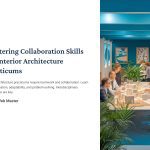 Interior architecture practicums require more than just design expertise—they demand seamless teamwork and collaboration. Successful projects hinge on effective communication, adaptability, and problem-solving among team members. As the industry shifts towards more interdisciplinary approaches, understanding key collaboration skills can set you apart in your career.
Interior architecture practicums require more than just design expertise—they demand seamless teamwork and collaboration. Successful projects hinge on effective communication, adaptability, and problem-solving among team members. As the industry shifts towards more interdisciplinary approaches, understanding key collaboration skills can set you apart in your career.

Effective Communication: The Foundation of Teamwork
Clear and concise communication is the backbone of any successful collaboration in interior architecture. Teams must ensure that ideas, design concepts, and project updates are effectively conveyed. Utilizing digital tools like Slack, Trello, or BIM (Building Information Modeling) software can streamline communication and keep everyone on the same page.
Active listening is just as important as speaking. Misunderstandings can lead to costly mistakes, so confirming instructions and clarifying doubts is crucial. Practicing constructive feedback also helps maintain a positive work environment, encouraging creativity and innovation.
Learn More About Communication Tools

Adaptability: Navigating Changes and Challenges
The field of interior architecture is dynamic, with design plans often evolving due to client requests, budget constraints, or unforeseen challenges. Adaptability is a key skill that allows teams to respond to these changes efficiently.
Being open to new ideas and solutions ensures smoother project execution. Whether adjusting to new software, revising a design concept, or addressing structural limitations, professionals who embrace flexibility are more likely to succeed. Cultivating a growth mindset and staying updated with industry trends can help individuals and teams stay competitive.
Stay Updated on Interior Architecture Trends
Conflict Resolution: Turning Differences into Strengths
Disagreements are inevitable in collaborative environments, but how they are handled can make or break a project. Understanding conflict resolution strategies helps maintain team harmony and ensures that creative differences lead to better solutions rather than setbacks.
Techniques such as active listening, finding common ground, and focusing on shared goals can help resolve conflicts constructively. Encouraging a culture of respect and professionalism fosters a collaborative atmosphere where all team members feel valued.
Explore Conflict Resolution Techniques

Time Management: Meeting Deadlines Without Compromising Quality
Interior architecture projects operate on strict deadlines, and effective time management ensures timely project completion without sacrificing quality. Team members must prioritize tasks, set realistic goals, and delegate responsibilities efficiently.
Using project management tools like Asana, Monday.com, or Microsoft Project can help teams stay organized. Regular progress check-ins and milestone tracking ensure that the project remains on schedule. Balancing efficiency with creativity is key to delivering high-quality work within deadlines.
Check Out Top Project Management Tools
Technical Collaboration: Integrating Skills and Expertise
Modern interior architecture relies on interdisciplinary collaboration between designers, architects, engineers, and contractors. Teams must integrate their expertise seamlessly to create functional and aesthetically pleasing spaces.
Using collaborative software like AutoCAD, Revit, and SketchUp allows different professionals to work on the same project efficiently. Understanding the technical language and workflow of other disciplines enhances teamwork and reduces errors in execution.
Explore Collaborative Design Software

Leadership and Team Roles: Maximizing Team Potential
Every team member plays a critical role in a successful interior architecture practicum. Understanding leadership dynamics and team roles helps distribute responsibilities effectively.
Strong leadership ensures clear direction, while well-defined roles prevent confusion. Recognizing individual strengths and assigning tasks accordingly enhances productivity. Encouraging initiative and accountability helps create a motivated team that delivers exceptional results.
Learn About Leadership in Design
*Capturing unauthorized images is prohibited*




